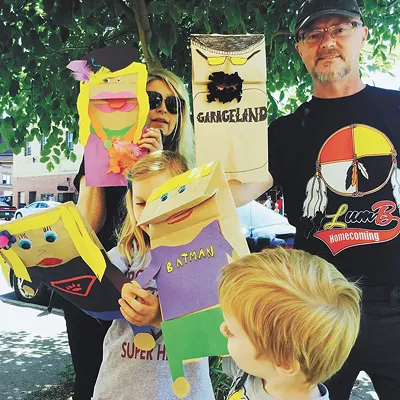It was odd to be back in the classroom after dozens of years away from school. The oddest part, at first, may have been the familiarity. Just as in the old days, there was the usual mix of types: the cut-ups and suck-ups, the know-it-alls and drones, even a dolt or two. And I even came down with classic classroom spring fever. The weather was gorgeous, and paperwork was drying up my brain. My gaze kept wandering to the window where the first flies of the season were drowsing and buzzing (as I was in danger of doing).
It says something that the highlight of the day turned out to be getting fingerprinted. Still, we were learning, on that day and others, by working through the by-the-book boilerplate, how to be U.S. Census Enumerators (Nonresponse Followup — NRFU — Enumerators, to be exact).
Enumeration, by the way, though it sounds like jargon, is straight from Article I, Section II, of the Constitution. I planned for this to be one of my talking points if challenged in the field, along with the fact the actual enabling law had been signed by none other than George Washington. (I never was challenged in quite that way. But I was ready.)
One fellow asked whether he could bring his concealed weapon along, and he was politely told, no. We imagined his true ambition was to be a door-bustin’ Special Tactics Enumerator: “Hit the floor, people! We’re the Census and we got questions!” We were supposed to be nice. If you could have boiled our training down to two lessons, they would have been Be Nice and Be Safe. There are penalties for noncompliance with the Census, but according to our crew leader, the last time anyone was prosecuted was 1960. (You have to wonder what else the guy did.)
As for safety, the Enumerator Handbook delivered such nuggets as, “As you walk towards your vehicle, scan beneath the vehicle for persons waiting to charge out at your ankles.” Pretty nimble they’d have to be, we decided. Lilliputian warriors or attack cats, we imagined, in which case they could likely be deterred by a pair of those spiky ankle bracelets.
Finally, we went out into the field on our own. The first day I worked with a partner, and we noticed we had competition. Would the Mormon missionaries we saw around our target neighborhood ease our path, or would they harden the people’s resolve against further intrusion?
We worried about such things. But now that I’m finished, at least with the NRFU operation, I have to say that most people were pretty good about the whole affair. Really.
True, there was that one neighborhood that could be defined by the scarcity of working doorbells. Some doorways show no trace of ever having had such a device. On some you can see where the doorbell had been pulled from the frame, sometimes with force. Some appeared intact, but the button made no sound when you pressed it, or maybe made a sound only a dog could hear. And once — I’d swear — the bell wire current must have surged directly into the rage center of a being whose meaty body then slammed full-length into the all-too-flimsy door with a crowing, gurgling snarl that conveyed just how much it wanted a piece of me …
And some people never answered their doors, because they were taking a rotation at the firehouse, or because they were asleep at midday — passed out, perhaps — or maybe because they’d been working the graveyard shift. Some were out forever: the house had been foreclosed upon, condemned or the resident was in the nursing home. Or you couldn’t tell if someone lived there because canny real estate agents had camouflaged the vacant house so well with stylish landscaping and timely mail pickup.
Or they answered the door to say they didn’t want to talk to you. Because they were sick. They were eating dinner. They were covered in paint. They’d never heard of the U.S Census, never.
Sometimes even when people were willing, it was tricky to determine who actually lived there. It got complicated, what with split custody and weekend liaisons. Or with, “The ex is sleeping on the couch, but she’ll be out of here any day now.” People’s lives were weaving in and out of these houses.
But through it all I realized the Census was hardly some invasive data-gathering juggernaut. In fact, it seemed positively cozy and quaint with its pencil and paper list of 10 questions. When things were going well, there was something almost sweetly patriotic about the process, as we traveled our appointed rounds. People thanked me, and shook my hand. They invited me into their homes, sat me down at the dining room table while we did the interview. I’d even been offered drinks, which I declined with a gallant, yet professional smile. Sometimes people just seemed to want to be counted, wanted just that minimal level of care.
Or sometimes it seemed they just wanted you to know that they were there, right now, in a house, holding on, though who knew how long it would last.
Steve Wing is a local freelance writer, among other things.




















